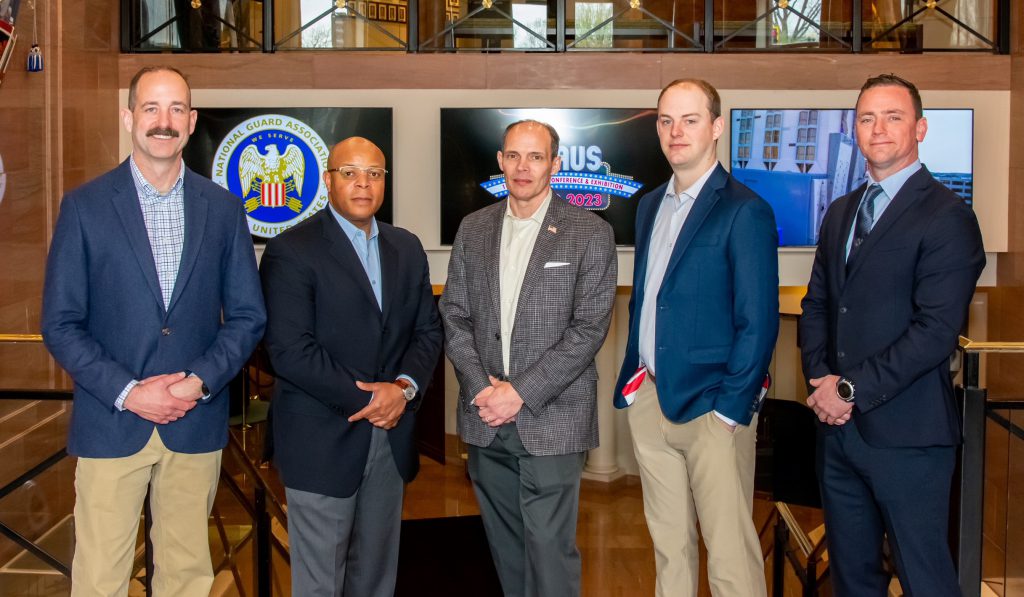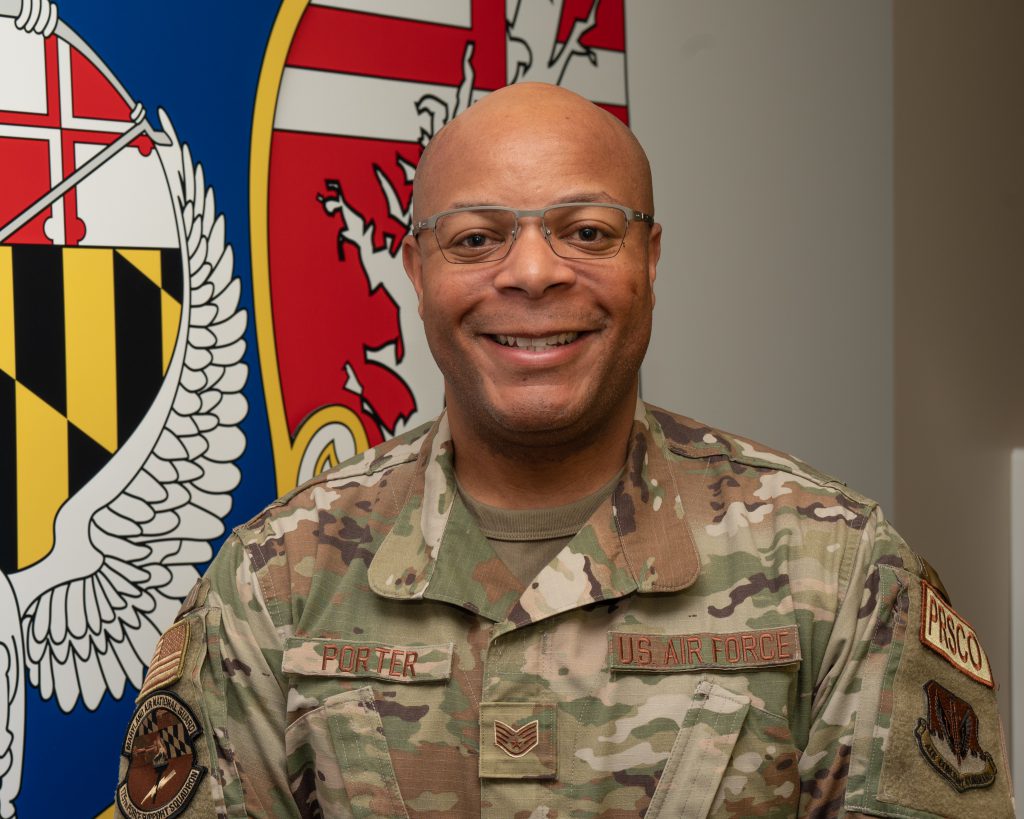Joint team secures funding for innovation
By Senior Airman Rachel Underwood

MIDDLE RIVER, Md. – Airmen from three Air National Guard Wings and a U.S. Army civilian from the U.S. Special Operations Command received $1.8 million from the U.S. Air Force to develop software to improve scheduled maintenance on all aircraft by centralizing the data in one system.
During their capstone pitch at the Academia Industry Military-Hybrid Innovations, they were one of the teams that presented solutions for emerging national defense problems to senior military leaders in late March.
The team was awarded funds for their solution from ARCWERX and Headquarters Air Force A4, which will be field tested at the 127th, 129th, and 175th Wings for development. This will be the first joint application to be tested on the Department of Defense’s Chief Digital and Artificial Intelligence Office’s Joint All-Domain Command and Control platform through the Condition Based Maintenance Plus program, currently managed by the Air Force Life Cycle Management Center.
U.S. Air Force Staff Sgt. Lamar Porter, a personnelist assigned to the 175th Mission Support Group and 175th Wing Spark Cell member, and his team were given a problem set focused on accelerated phased maintenance of aircraft and military systems.
“The challenge statement we received was how to improve the phased maintenance process,” Porter said. “So basically going through the process of dissecting a challenge statement and trying to figure out how to exercise that from a hypothesis and do a systematic process of elimination to figure out how you’re going to focus on fixing that issue or that gap.”
The team was able to present a solution set and a model that brings in different datasets and data systems together in an environment that enables maintainers, pilots, commanders and other parties to look at the same data impacting phased maintenance in real-time.
“Think of phased maintenance as routine maintenance on your car,” said U.S. Air Force Col. David Wright, commander of the 175th Maintenance Group. “You know how the owner’s manual contains a detailed list of what needs to be inspected at certain mileage intervals? Phased Maintenance is just like that, only a lot more involved, at much shorter intervals and done by true experts who hold the life of pilots in their hands and take it very seriously.”
AIM-HI connects top academic institutions and industry-leading companies with military members across the services. The 10-week program capstone links real-world issues and operational priorities with functional innovative solutions required to accelerate change across the DoD.
The program partners with the University of Michigan and Michigan National Guard’s Kelly Johnson Joint All-Domain Innovation Center to advance professional development education to military students attending AIM-HI along with ARCWERX. ARCWERX was created to foster a culture of innovation for Guardsmen and Reservists.
The Cohort 4 capstone pitch event allowed senior leaders from Joint Base Andrews, the Pentagon, National Guard Bureau and other organizations to hear solutions to complex real-world operational issues.
The curriculum for the 10-week course was developed by Rob Olson and Jeff Degraff, professors from Duke University and the University of Michigan, and structured through the University of Michigan School of Business and Engineering.
“In the first week, we were basically going through the process of learning what innovation is, what does innovation look like within DoD and then we got our challenge statements,” said Porter. “The challenge statement focused on how to improve the phased maintenance process.”
The Airmen tested and evaluated a locally built maintenance quality assurance Microsoft Excel-based application called the Maintenance Inspections Data Analysis System created by a member of their team. MIDAS was built to integrate various data points from over four enterprise wide quality assurance and inspection systems of records.
“MIDAS is a system of Excel nodes that connect together to provide a wide-net, group-level picture of our organization’s health,” said U.S. Air Force Senior Master Sgt. Jonathan Borth, Aircraft Rescue Maintenance superintendent of the129th Rescue Maintenance Group, Innovation Programs director for the 129th Rescue Wing, and creator of MIDAS. “Think commander’s dashboard pulled from a bunch of tools built for flight chiefs to manage their sections.”
MIDAS was originally created due to a low rating on a Unit Effectiveness Inspection at the 129th Rescue Wing.
“It wasn’t an issue of poor management as much as just being slow on the uptake,” explained Borth. “I revamped the group-level programs and found that we really didn’t have many tools for our teams to use in operations and the reports we were creating were very time consuming.”
“Some of these reports would take 8-10 days to generate for the commanders,” said Borth, “and MIDAS found its groove in delivering those reports within 15 minutes.”
By the sixth week of the program, Porter and his team decided to adopt MIDAS as the solution to their given problem set and began pitching the solution to other parties.
“That’s when I brought it to the 175th Wing and started interviewing members of our Wing,” said Porter. “We also started interviewing members within other Wings and the DoD on the viability and feasibility of MIDAS as a solution for phased maintenance.”
The solution the team is positioned to improve upon and bring to the market is the use of artificial intelligence and machine learning to combine different data streams used in phased maintenance into one program.
“We use AI and [machine learning] to bring all these different data streams into one wheelhouse to basically provide different dashboards and decision making capabilities at different levels and different domains,” said Porter. “So basically better data, better decisions, and better capacity in real time.”
Porter and his team successfully secured technical partnership and Project Management Office support from the Rapid Sustainment Office’s CBM+ Program as they deploy AI-based programs to the enterprise.
The team discovered that this solution should be further vetted and matured by other Wings to include data from manpower, logistical, and depot systems of record to integrate all readiness and operational data to allow for more artificial intelligence and machine learning.
Each Wing involved will have a member from Porter’s team to act as the point of contact for the duration of the testing efforts.
“In terms of pilot safety, phased maintenance of an aircraft is a top priority, and I am looking forward to testing a system [MIDAS] that could help our Airmen be more effective in that process,” said U.S. Air Force Senior Master Sgt. Shawn Kennedy, inspection element superintendent assigned to the 175th Aircraft Maintenance Squadron. “I’ve learned that the California Air National Guard is currently having success with MIDAS, but we operate a different airframe so I am eager to get into the system to find out if it will benefit the A-10 community.”
The team presented MIDAS as the solution to the phased maintenance problem given to them at AIM-HI, but MIDAS can be used to improve upon other systems in the DoD.
“Phased maintenance was the primary challenge statement,” said Porter, “but the solution set we presented was operational readiness writ large to include depots, manpower, assets and phased maintenance processes. Those four primary domains are what our solution captured.”

